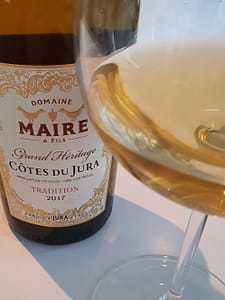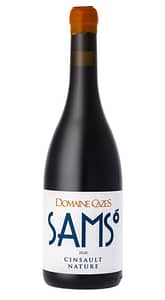As the rain set in on the rugged coast we wanted a bold wine for the cheeseboard. Luckily this Côtes du Jura was offered by the local store.
Domaine Maire is one of the largest producers of Jura covering 234 hectares of vines, and they sell their wines at affordable prices. The word tradition on the label here refers to a typical blend of the local white grapes varieties ahardonnay and savagnin. Maire’s cuvée comprises around 80% chardonnay and 20% savagnin.
Chardonnay, originating from Burgundy but cultivated in Jura since the 10th Century, has become a native, and is especially well suited on limestone and light soils. The savagnin is typical to Jura and matures slowly on grey marl soils. It’s the ideal grape variety for an oxydative maturing process under a veil of “flor”, referred to locally as “sous voile”. Most of the chardonnay was aged in stainless steel tanks for 2-3 months, the rest on fine lees in wooden vats for the same period of time. A part of the savagnin juices were matured in oak barrels under flor for 8 to 12 months.
Grand Héritage Tradition 2017 (Dom. Maire)
Yellow with green hints; apples and flowers (from chardonnay), flor, butter, roasted almonds and nuts (from the savagnin ageing); full in the mouth, good and persistent acidity, meaty.
Price: Medium
Food: Comté or blue cheeses, tapas, shellfish, paté, charcuterie
Leave a Comment
















